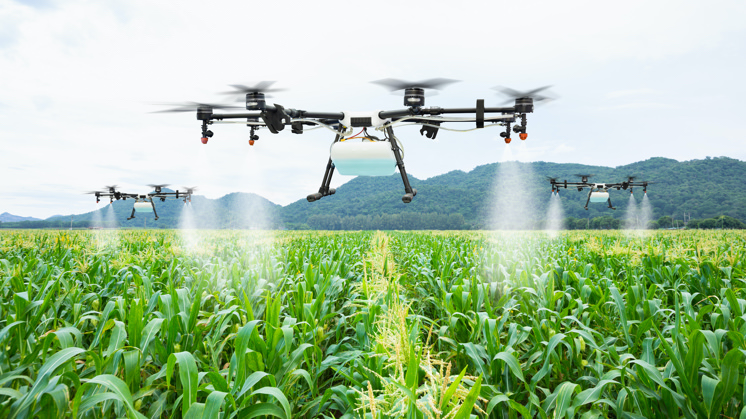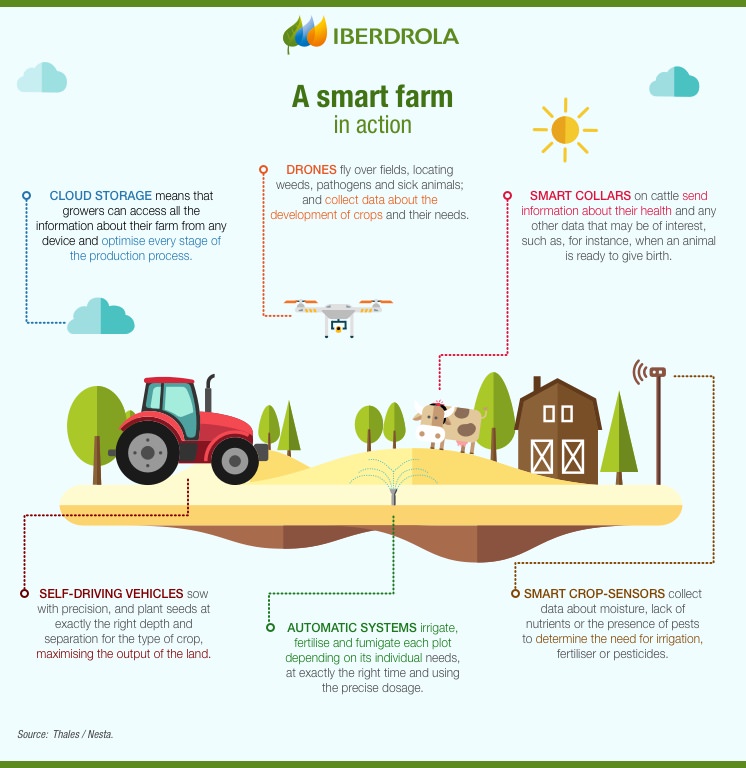Smart Farming and precision agriculture
Smart farming, precision agriculture to achieve a more sustainable world
Drones that monitor hundreds of acres to assess the health of crops and animals, smart sensors to help in the early detection of infestations, and automatic systems that water, fertilise and fumigate each plot depending on its specific characteristics and on the weather forecast. These are just some of the virtues of smart farming - the concept that may help to eradicate hunger in an over-populated future.

According to UN calculations, by 2050 there will be 9.7 billion people in the world, in other words around 2 billion more mouths to feed than in 2020. This increase, according to FAO — the UN food an agriculture agency —, needs to be met through a 70 % rise in agricultural production.
The situation poses a serious challenge to the member states of the UN with regard to the 2030 Agenda, and specifically SDG 2, which aims to end world hunger by ensuring access for all, especially the poor and vulnerable, including babies, to healthy, nutritious and sufficient food throughout the whole year. And all this without forgetting that in addition, the food industry is currently responsible for 30 % of the world's energy consumption and 22 % of greenhouse gas emissions. The challenge, therefore, is not just producing more food, but doing it sustainably.
WHAT IS SMART FARMING, OR PRECISION AGRICULTURE
Smart farming is about using the new technologies which have arisen at the dawn of the Fourth Industrial Revolution in the areas of agriculture and cattle production to increase production quantity and quality, by making maximum use of resources and minimising the environmental impact. Also, the implementation of technology in agriculture and cattle production will make it possible to boost food security throughout the world.
Gracias a estas nuevas tecnologías, un terreno de cultivo puede fraccionarse en tantas parcelas como diferencias internas tenga dicho terreno: variaciones en la composición del sustrato, existencia de depresiones, propensión al estancamiento de agua, presencia de depredadores o grado de porosidad, entre otras características, y aplicar sobre cada parcela un tratamiento personalizado para sacarle el máximo rendimiento. Esto es lo que también se conoce como precision agriculture.
AGRICULTURE AND NEW TECHNOLOGIES
Among the technologies that are revolutionising the present, and that will define the future of agriculture, the most notable are:
 Drones
Drones
Drones simplify supervision tasks for farms by being able to cover hundreds of acres in one flight, gathering, thanks to infrared technology, multispectral images and a wide variety of information about the condition of the land, irrigation needs, crop growth, the existence of pathogens, and, in the case of cattle, the number of animals, their weight and possible anomalies such as lameness or unusual movements.
 IoT
IoT
The Internet of Things makes it possible to optimise the monitoring of farms, mainly through smart sensors capable of measuring everything from solar radiation to leaf moisture and stem diameter, or the temperature of each animal in the case of livestock, making it easier to make all sorts of management decisions.
 Big data
Big data
Thanks to the ability of big data to analyse massive amounts of data, farmers can manage all the information obtained from drones, the Internet of Things and other measuring instruments and integrate it both with historical information for the farm and with weather data, in order to optimise all stages of the production process.
 Blockchain
Blockchain
Blockchain makes it possible to monitor crops and cattle from growth until handover to suppliers, improving, for example, the traceability of the supply chain. By using this technology, if an imported vegetable poisons consumers the source of the outbreak can be easily traced and only the affected products withdrawn, instead of prohibiting imports of vegetables from the entire country of origin.
 Inteligencia artificial
Inteligencia artificial
In agriculture, artificial intelligence and robotisation are used mainly to interpret field images and apply fertilisers and pesticides with surgical precision, or for dealing with weeds. On a farm, for instance, it means that microphones can be used to identify squealing piglets that are being squashed by their mother, and a vibration can be sent to her through a sensor to make her get up.

SEE INFOGRAPHIC: A smart farm in action [PDF]
THE BENEFITS OF SMART FARMING
The application of the above technologies has a positive impact on agriculture and cattle farming. Let's take a look at some of these improvements:
- Increased production: the optimisation of all the processes related to agriculture and livestock-rearing increases production rates.
- Water saving: weather forecasts and sensors that measure soil moisture mean watering only when necessary and for the right length of time.
- Better quality: analysis of the quality of the produce obtained in relation to the strategies applied makes adjustments possible to increase subsequent production quality.
- Reduced costs: automation of sowing, treatments and harvesting in the case of agriculture reduces the use of resources.
- Pest detection and animal health: early detection of infestations in crops or sickness in animals means that their impact on production can be minimised and animal welfare improved.
- Better sustainability: saving resources like irrigation water and getting maximum benefit from the land reduce the impact on the environment.




